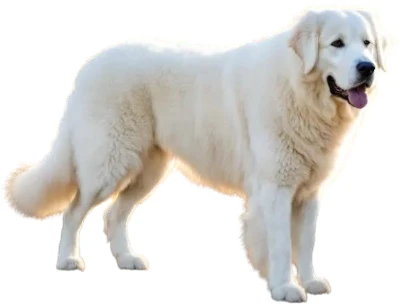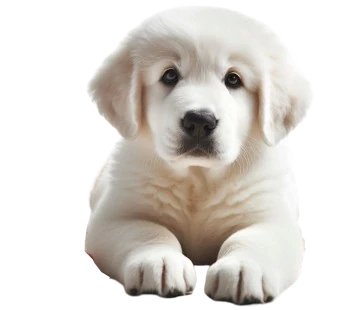
The Kuvasz is a dog breed originating from Hungary, historically used to guard sheep herds from predators. This breed is famous for its courage and its ability to protect its territory. This large dog has also been a loyal companion of Hungarian nobility throughout the centuries.
The Kuvasz is a large, powerful dog with a robust build. Males typically stand between 65 and 76 cm at the shoulder, while females range between 60 and 70 cm. It has a well-proportioned body and long, dense, wavy white fur, which made it easier to distinguish from predators when guarding herds.
The Kuvasz has a double coat: a dense outer layer and a soft insulating undercoat. The white coat, emblematic of the breed, provides protection against the elements and predators. Regular brushing is necessary to prevent matting, especially during shedding periods when the undercoat is renewed.
Male Kuvasz dogs measure between 70 and 76 cm, while females measure between 65 and 70 cm. Their weight varies between 40 and 60 kg for males, and between 30 and 50 kg for females. Their large size and strong build make them particularly imposing dogs.
The Kuvasz is an intelligent, independent, and courageous dog. It is naturally protective and can be wary of strangers, but is extremely loyal and affectionate with its family. It makes an excellent guard dog, but early socialization is necessary for it to interact well with other dogs and people. Its independent nature can make training challenging, but it responds well to positive and consistent methods.
The Kuvasz is generally a healthy breed, but due to its large size, it may be prone to conditions such as hip dysplasia or joint issues. A balanced diet, moderate exercise, and regular veterinary check-ups are essential for maintaining its health.

The Kuvasz puppy is a large dog originating from Hungary, known for its thick, silky white coat. Traditionally used for guarding livestock, this dog has a courageous and protective temperament. The Kuvasz is very attached to its family, showing great loyalty, though it may be wary of strangers. Early socialization and consistent training are necessary to channel its strong protective instinct. This active dog also requires regular physical activities to meet its energy needs. The Kuvasz is ideal for families living in spacious environments and leading an active lifestyle.
The price of a Kuvasz puppy can vary depending on the breeder and pedigree. On average, expect a budget of around 1,200 euros.
The Kuvasz is a breed of sheepdog originating from Hungary, known for its imposing size, loyalty, and protective instincts. Training a Kuvasz requires a firm yet kind approach that respects its independent character and guarding instincts.
It is essential to start training from a young age. Socialization is crucial to accustom the dog to various environments and interactions. Kuvasz are naturally protective and can be wary of strangers, so gradual and positive exposure is beneficial.
Using positive reinforcement, such as treats and praise, is very effective. Avoid harsh punishments, as they can reinforce the Kuvasz's natural aggressiveness. These dogs respond well to a calm and consistent approach.
Finally, providing enough physical and mental exercise is important. Regular walks and interactive games stimulate their mind and help them stay balanced. A well-established daily routine also contributes to their overall well-being.